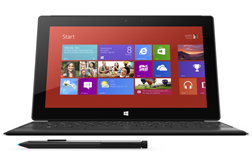It can be easy to forget how lucky we are….
*****despite Bill’s picture appearing above, this is still me – Gareth :) *****
I received my new work machine yesterday – a Surface Pro, and like every good geek, I ripped open the box and immediately started setting it up. Every time I do this, I think about how I used to set up machines before the technology (and processes) improved dramatically.
What I used to do was:
1. Re-install the operating system and connect to the network
3. Set up security and login configurations
4. Install my applications one by one from CD or a network share
5. Move my files over from an external drive
6. Go home as the day is now over and my machine is nearly ready…..
What I do now:
1. Do a network boot, enter my username and password, choose a couple of options and then go away and make a cup of tea. Later – the machine is set up with my key applications, my personal data is coming down over Skydrive, and my work data is coming down over Skydrive Pro.
2. Go to the Windows Store, swipe to get the options menu which displays the “Your apps” option. This hidden gem in Windows 8 lets me see all the apps I have installed on my other Windows 8 PCs and install them all to this new device. Simple :)
3. Wonder what else to do with my day…. as I am all set up and ready to go.
What does this have to do with health?
It’s easy to become complacent with the level of IT support we have (and you would expect us to have good IT, wouldn’t you)? The best bit though is meeting customers who have similar levels of support for their users. I have met a number of large providers recently in the US who deliver exactly this level of support – and get the IT (or at least infrastructure) out of the way of the clinicians – and it is great to see. One customer I met recently is at the stage of looking how they start to provide apps to their patients, and whether they should build an app store, or simply point to “approved” apps in other stores. Really interesting dilemmas, and it will be fascinating to see how this moves forward. One other hospital we have been working with (this one is outside of the US) is doing some amazing stuff with Windows 8, desktop virtualization and devices and we are going to share much more about what they have been doing in a couple of weeks.
What do I do if my hospital is not quite so advanced?
If your IT team are spending their time doing break fix rather than being proactive, I strongly advise you to look here at the Infrastructure Planning and Design Guides (IPD)- its one of our best kept secrets and gives you architectural guidance and advice on how to think about your infrastructure to get to a more advanced place, often with software you already own.
Use the comments to let us know where you are on the scale, and whether the IPD guides are useful.
Gareth
Windows 8 lead – Worldwide Health at Microsoft